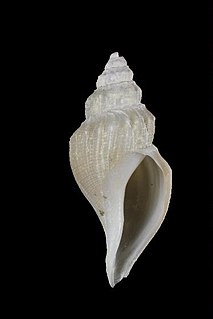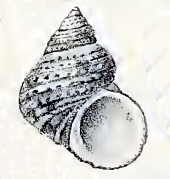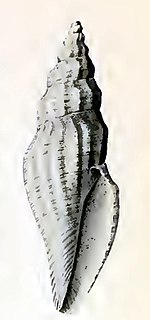Related Research Articles

Goniatites is a genus of extinct cephalopods belonging to the family Goniatitidae, included in the superfamily Goniatitaceae. Hibernicoceras and Hypergoniatites are among related genera.
Pseudohaloritidae is the larger of two families that form the goniatitid superfamily Pseudohaloritoidea, the other being the monogenerc Maximitidae. They are part of the vast array of shelled cephalopods known as ammonoids that are more closely related to squids, belemnites, octopuses, and cuttlefish, than to the superficially similar Nautilus.
Spyroceras is a genus of pseudorthocerids from the Devonian of North America and Europe, defined by Hyatt in 1884. Pseudorthocerids are a kind of orthocertaoid, a taxonomic group within the Nautiloidea. Specifically Spyroceras belongs to the pseudorthocerid family, Spyroceratidae.
Syringonautilidae is a family of Nautiloidea from the middle to late Triassic. Syringonautilidae comprise the last of the Trigonoceratoidea and are the source for the Nautilaceae which continued the Nautiloidea through the Mesozoic and into the Cenozoic right down to the recent. Syringonautilidae is a strictly Triassic family, derived early in the Triassic from the Grypoceratidae.
The Trigonoceratidae is a family of coiled nautiloid cephalopods that lived during the period from the Early Carboniferous (Mississippian) to the Early Permian.

Mitromorpha alphonsiana is a species of sea snail, a marine gastropod mollusk in the family Mitromorphidae.

Marshallena nierstraszi is a species of sea snail, a marine gastropod mollusk in the family Marshallenidae
Cryptogemma periscelida, common name the Atlantic gem turrid, is a species of sea snail, a marine gastropod mollusc in the family Turridae, the turrids.

Brachytoma rioensis is a species of sea snail, a marine gastropod mollusk in the family Pseudomelatomidae.

Clavus subobliquatus is a species of sea snail, a marine gastropod mollusk in the family Drilliidae.

Tectus mauritianus, common name the Mauritius top shell, is a species of sea snail, a marine gastropod mollusk in the family Turbinidae, the turban snails.

Tectus pyramis, common name the pyram top shell, is a species of sea snail, a marine gastropod mollusk in the family Turbinidae, the turban snails.

Turbo stenogyrus, common name the miniature turban, is a species of sea snail, marine gastropod mollusk in the family Turbinidae.
Shouchangoceras is a genus of goniatitid pseudohaloritid ammonoids and is the type genus for the pseudohaloritid subfamily Shouchangocerinae. The genus is characterized by a compressed shell as much as 5 cm in diameter, with a strongly constricted mature peristome that has shallow dorsolateral sinus, a moderately deep rounded ventral sinus, but without conspicuous lappets, and ornamented by moderately strong transverse ribs and numerous stronger longitudinal lirae, producing a weakly reticulate pattern. Lobes are attenuate. The siphuncle is within the dorsal septal flecture.
Doulingoceras is a genus of ammonoid within the ceratitid order, found in China, that lived during the Late Permian during the time span from about 260.5 to 254 million years ago. The genus is included in the family Paraceltitidae, which belongs to the superfamily Xenodiscaceae.

Clanculus euchelioides, common name the small top shell, is a species of sea snail, a marine gastropod mollusk in the family Trochidae, the top snails.

Perrinia elisa is a species of sea snail, a marine gastropod mollusk in the family Chilodontidae.

Perrinia squamicarinata is a species of sea snail, a marine gastropod mollusk in the family Chilodontidae.
Branneroceras is a goniatitid genus from the Late Carboniferous. Their fossils have been found in Nunavut, Canada, and in Arkansas and Texas, USA.

Guraleus tasmanicus is a species of sea snail, a marine gastropod mollusk in the family Mangeliidae.